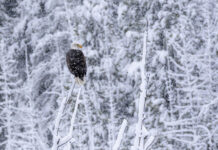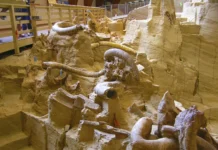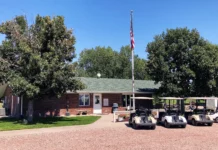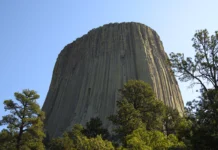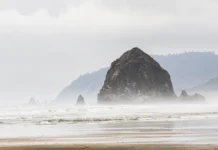| NEBRASKA |
Nebraska is infamous for its nearly nonstop winds, especially in the western half of the state. Wind speeds that would set off hurricane warnings on both coasts, and send panicked denizens racing to seek shelter, often constitute just another Tuesday for residents of the Cornhusker state.
| IN THE ABSENCE OF FUEL
Augustus F. Harvey, pioneer, teacher, and newspaper editor wrote in 1869, “The absence of fuel for manufacture is more than compensated for by the excessive dryness of the atmosphere and the consequent rapidity of evaporation. From the 1st of April to the middle of November, scarcely a day passes without warm, dry wind. During June, July, August, and September, the winds are almost constant.”
Love it, or hate it, without this constant wind moving loose sand as the massive Pleistocene glaciers began to erode the Rocky Mountains and wash sediment onto what is now the Great Plains nearly 10,000 years ago at the end of the last Ice Age, one of the rarest ecosystems on the planet would not exist, and neither would one of the rarest flowers in North America, the highly endangered Blowout Penstemon.
| A STABLE ECOSYSTEM
The Nebraska Sandhills cover nine counties in Nebraska and constitute nearly 20,000 square miles, one-fourth of the entire state of Nebraska, and is the largest dune formation in the Western Hemisphere, with dunes that easily reach 400 feet high and stretch for 20 miles. Most of this area is stabilized by 720 identified species of plants, with 650 classified as native.
In some areas, though, especially at the very tops of these massive dunes and with northwest-facing exposures, the wind destabilizes the roots of plants, making it impossible for them to survive and excavating barren depressions called blowouts.
These blowouts can range from smaller areas than a dining room table to massive holes hundreds of feet in diameter. They are constantly on the move as the wind pushes them across the Great Plains, eroding the soil a few feet at a time in a slow march that can last for decades.
It would appear to the casual observer that nothing could survive in these arid bowls of sand, yet some plants thrive in these conditions. One of these is Blowout Penstemon, one of the world’s rarest and most endangered wildflowers.
Standing less than two feet tall, with clusters of milky blue to dark lavender flowers, and on the rarest of occasions found with white blooms, this perennial is found in only a few counties in the Sandhills, including the northern portions of Morrill and Garden counties, and in a small section of Carbon County, Wyoming.
Also known as Hayden’s Penstemon, or Blowout Beardtongue, Blowout Penstemon was first collected by the explorer and geologist Ferdinand V. Hayden (giving the flower its Latin name, Penstemon Haydenii) in 1857 along the banks of the North Loup River.
Once one of the most commonly found plants in the Nebraska Sandhills, after the Kincaid Act of 1904 opened Nebraska and Wyoming to farming and grazing, the plant’s population declined rapidly, and by 1940 it was thought to be extinct. It was not rediscovered until 1968.
Blowout Penstemon, along with lemon scurfpea and blowout grass, is one of the first plants to establish itself in newly formed blowouts. Although it does produce seeds, they have a thick seed coat, contain a chemical inhibitor within the seeds themselves, and, if viable, often germinate in areas where it is too dry for the seedlings to establish themselves, so the flower most commonly reproduces through rhizomes, which stabilize the shifting sands of the blowout, eventually leading to its own demise as other plants begin to move into the now habitable area and crowd it out, usually within six to eight years.
Blowout Penstemon does not bloom until its second year, forming buds on the stems of the previous year’s growth. The species begins to grow and form buds in early spring but does not bloom until mid-May and continues throughout the summer.
The large blooms attract various pollinators, from bees to ants and butterflies. Each plant produces 500-600 viable seeds, which are then spread by animals and the wind to new blowouts in the region, where they can remain buried for decades until ideal moisture and abrasion of the hard seed covering are achieved.
The blowouts are becoming increasingly scarce due to the loss of blowout habitat through fire suppression and land management techniques. The plant faces other threats, including drought, construction, livestock grazing, and off-road vehicles driving in undesignated areas. The population is being stabilized by transplanting greenhouse-grown seedlings into carefully managed blowout sites.
If you are lucky to discover one of these extraordinary flowers on your next excursion into the Sandhills, please remember to look and not touch. As tempting as it may be to dig up a rhizome and transplant it to your garden, remember that this is a federally declared endangered species, and taking one from public lands can carry a penalty of up to $25,000 and six months in jail. So, once again, don’t forget your camera and tick spray, and get out there and discover another part of Western Nebraska.
| RESOURCES
- Nebraska Game & Parks Service
- Blowout penstemon, aka Blowout beardtongue
- U.S. FWS – ECOS – Environmental Conservation Online System
- U.S. Forest Service
Story by: Kathrine Rupe
Photography: Vernon Jenewein







